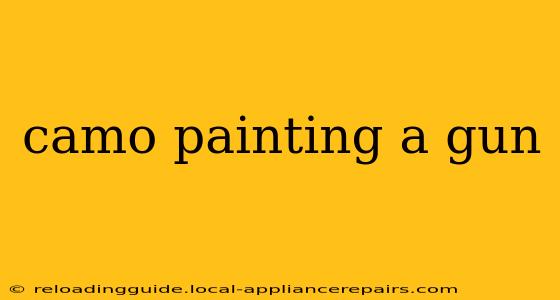Camo painting your firearm can significantly enhance its concealment in various environments, offering tactical advantages for hunters, outdoorsmen, and enthusiasts alike. However, a successful camo job requires more than just slapping on some paint. This guide will walk you through the entire process, from preparation to final touches, ensuring a professional and durable finish that will withstand the rigors of the field.
Preparing Your Firearm for Camo Painting
Before you even think about picking up a paintbrush, thorough preparation is crucial for a long-lasting, high-quality camo pattern. This step is often overlooked, yet it directly impacts the final result.
1. Cleaning and Disassembly:
- Thorough Cleaning: Start by meticulously cleaning your firearm. Remove all traces of oil, grease, dirt, and residue. This ensures proper paint adhesion and prevents future issues. Use a suitable gun cleaning solvent and patches, paying attention to all crevices and moving parts.
- Partial or Full Disassembly: Depending on your comfort level and the firearm's design, consider partial or full disassembly. This allows for easier access to all surfaces and ensures even paint coverage. Always consult your firearm's manual before disassembling it. If you're unsure, seek professional help.
2. Surface Preparation:
- Sanding (Optional): Lightly sanding the firearm's surface with fine-grit sandpaper (220-grit or higher) can improve paint adhesion, especially on smooth surfaces. Focus on creating a slightly rough texture, not deep scratches. Remove any sanding dust with compressed air or a tack cloth.
- Degreasing: Even after cleaning, a degreasing agent is recommended. Apply a degreaser according to the manufacturer's instructions and wipe thoroughly with a clean cloth. This removes any remaining oils or contaminants.
- Masking (If Necessary): Use painter's tape to mask any areas you don't want to paint, such as sights, markings, or functional components. Ensure the tape is securely applied to prevent paint bleed-through.
Choosing Your Camo Paint and Supplies
The success of your camo job hinges on selecting the right materials.
1. Paint Selection:
- Type: Consider using specialized camouflage paints designed for firearms. These paints are often durable, weather-resistant, and formulated to withstand the recoil and environmental conditions firearms are exposed to. Some popular choices include Krylon, Rust-Oleum, and specialized camouflage paint brands.
- Colors: Choose colors appropriate for your intended hunting or tactical environment. Popular camo patterns include woodland, desert, and multi-terrain patterns. You can also create your custom blend.
- Finish: Consider a matte finish for maximum concealment. Glossy finishes reflect light and compromise camouflage effectiveness.
2. Essential Supplies:
- Paintbrushes: Choose high-quality brushes with fine tips for detail work and broader brushes for larger areas. Consider using different brush sizes for different areas of the firearm.
- Spray Cans (Optional): Spray cans provide a smoother finish, particularly for larger areas. Ensure you're using spray paint suitable for firearms and apply multiple thin coats.
- Gloves: Protect your hands with disposable gloves.
- Masking Tape: High-quality painter's tape is essential for masking sensitive areas.
- Drop Cloths: Protect your work surface from paint spills.
- Clear Coat (Optional): Applying a clear coat sealant after the camo paint is dry will add an extra layer of protection and durability.
Applying the Camo Paint
This is where the artistry comes in.
1. Applying Base Coats:
Apply thin, even coats of your base colors, allowing each coat to dry completely before applying the next. Avoid thick coats, as they may crack or peel.
2. Creating Your Camo Pattern:
There are numerous camo patterns, each with its own unique technique. Whether you're aiming for a classic woodland pattern or a more modern digital camo, research the pattern beforehand and practice on a scrap piece of material to get a feel for it before applying it to your firearm.
3. Applying Detailing:
Once the base colors are dry, add details and highlights using lighter and darker shades to create depth and realism. A well-executed camo job utilizes a variety of shades and textures to break up the firearm’s silhouette.
4. Sealing (Optional):
Once completely dry, apply a clear coat sealant to protect the camo job from scratches and wear.
Final Touches and Considerations
- Reassembly: Carefully reassemble your firearm after the paint has completely cured.
- Testing: After reassembly, carefully inspect your firearm for any areas that may need additional attention.
- Safety First: Always handle firearms safely. Never point a firearm at anything you do not intend to shoot.
Camo painting your gun is a rewarding project that can improve both its appearance and effectiveness. With careful preparation, the right materials, and attention to detail, you can achieve a professional-looking camo job that will enhance your firearm's performance and concealment. Remember, practice and patience are key to achieving the desired results.

